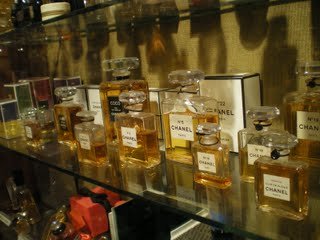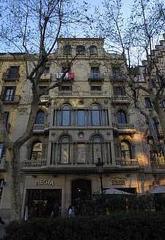
Perfume Museum Barcelona: The Complete Visiting Hours, Tickets, and Travel Guide
Date: 14/06/2025
Introduction
Nestled in the heart of Barcelona, the Museu del Perfum (Perfume Museum) offers a unique journey through the history and artistry of fragrance. Established by Ramón Planas Buera in 1961 and opened to the public in 1963, the museum is renowned for its comprehensive collection of over 5,000 perfume bottles, artifacts, and memorabilia spanning ancient civilizations to the present day (Museu del Perfum; Wikipedia). Although temporarily closed for relocation as of January 2024, the museum remains one of Barcelona’s hidden cultural gems, reflecting the city’s long-standing tradition as a crossroads of art, trade, and innovation (Spain Inspired).
This guide provides detailed insights into the museum’s history, collection highlights, practical visitor information—including accessibility, visiting hours, and ticketing—as well as tips for exploring nearby attractions. Whether you’re a fragrance enthusiast, a history buff, or an art lover, the Museu del Perfum promises a sensory and educational experience unlike any other.
Table of Contents
- Founding and Historical Development
- Evolution of Perfume Through the Ages
- Artistic and Cultural Significance
- Visiting Hours and Tickets
- Accessibility
- How to Get There
- Nearby Attractions
- Special Events and Guided Tours
- Notable Artifacts and Highlights
- Frequently Asked Questions (FAQ)
- Visuals and Media
- Related Articles and Internal Links
- Summary and Travel Tips
- References
Founding and Historical Development
The Museu del Perfum was founded in 1961 by Ramón Planas Buera, an esteemed Spanish perfumer and collector (Museu del Perfum). The museum opened within the iconic Perfumeria Regia at Passeig de Gràcia 39, a prestigious location symbolic of Barcelona’s cultural and architectural grandeur (IR Barcelona). Planas Buera’s vision was to create a space honoring perfume’s evolution, not only as a sensory pleasure but as a reflection of societal change and artistic progress.
Over the years, the collection grew to more than 5,000 pieces, encompassing perfume bottles, miniatures, catalogues, labels, and historic advertising. The museum became notable for its multidimensional displays, offering visitors a comprehensive view of perfumery’s journey from ancient times to the modern age (Wikipedia).
As of January 31, 2024, the museum’s original site is closed for relocation. Updates will be posted on the official museum website.
Evolution of Perfume Through the Ages
Ancient Civilizations
The museum’s earliest artifacts originate from Mesopotamia, Egypt, Greece, Etruria, Phoenicia, Carthage, and Rome (Museu del Perfum History). These cultures crafted perfume vessels from bronze, ceramics, ivory, and glass, reflecting both technological prowess and aesthetic values. Ancient scents played vital roles in religious rituals, daily grooming, and medicinal practices (Barcelona Passeig de Gràcia).
Medieval and Renaissance Europe
Islamic scholars advanced distillation methods, influencing European perfumery during the Middle Ages. The museum features Islamic containers adorned with geometric motifs, as well as Renaissance-era bottles from Venice and Florence, where perfume became a luxury for the elite (Museu del Perfum History).
The Industrialization of Perfume
The late 18th century marked perfumery’s shift from artisanal craft to mass production. France, particularly Grasse and Paris, emerged as industry leaders. The museum’s modern collection includes commercial bottles and packaging from pioneering brands, highlighting changes in marketing, design, and consumer culture (Museu del Perfum History).
Artistic and Cultural Significance
The Museu del Perfum is more than a repository of objects; it captures the intersection of art, culture, and the senses. Bottle designs range from the geometric elegance of antiquity to the flamboyance of Art Nouveau and the innovation of contemporary artists like Salvador Dalí. According to founder Ramón Planas, the museum offers “a lesson in art history and a treat for the eyes” (Museu del Perfum).
Culturally, the museum reflects Barcelona’s status as a Mediterranean hub, shaped by centuries of trade and artistic exchange. It also preserves Catalan and Spanish traditions of scent and self-expression (Spain Inspired).
Visiting Hours and Tickets
Current Status
As of early 2024, the Museu del Perfum is closed for relocation. The reopening date and new address will be announced on the official website.
Usual Opening Hours (when open)
- Monday to Friday: 10:30 a.m. – 8:00 p.m.
- Saturday: 11:00 a.m. – 2:00 p.m.
- Sunday & public holidays: Closed (SHBarcelona; Museos.com)
Tickets
- Adults: €5
- Children: €3
- Discounts: 40% off for Barcelona Card holders
- Purchase: Tickets sold at the Perfumería Regia counter; cash recommended
- Online Booking: Not typically available—check for updates
Accessibility
The museum’s original location was generally wheelchair accessible, with flat entry and navigable aisles, though somewhat narrow. Accessible toilets are available. For detailed accessibility information and special accommodations, contact the museum directly before your visit (Barcelona Turisme; Barcelona.de).
How to Get There
When open at Passeig de Gràcia 39, the museum is easy to reach via:
- Metro: Passeig de Gràcia station (L2, L3, L4)
- Bus: Multiple city routes stop nearby
- Taxi: Accessible taxis widely available
- Parking: Several public garages in the area; limited street parking
For future updates regarding the new location and directions, refer to the official museum website.
Nearby Attractions
The museum’s central location places it within walking distance of many major Barcelona historical sites:
- Casa Batlló and Casa Milà (La Pedrera): Gaudí masterpieces
- Plaça Catalunya: City’s main square
- Picasso Museum and MNAC: Leading art institutions
- Passeig de Gràcia: Renowned for shopping and dining
Combining your Perfume Museum visit with these landmarks enhances your cultural itinerary (Museos.com; Barcelona Passeig de Gràcia).
Special Events and Guided Tours
The museum offers guided tours (occasionally in multiple languages), temporary exhibitions, and perfume-making workshops. These enrich the visitor experience and provide deeper insight into the art and science of perfumery. Check the official website and social media for announcements.
Notable Artifacts and Highlights
- Ancient Containers: Egyptian alabaster phials, Greek lekythoi, Roman glass bottles
- Islamic and Renaissance Bottles: Illustrate cross-cultural exchange
- Marie Antoinette’s Perfume Box: Rare royal artifact (Wikipedia)
- Salvador Dalí’s “Le Roi Soleil”: Iconic artist-designed bottle
- Modern Commercial Bottles: Show evolution of marketing and design
Interactive displays (when available) offer sensory engagement, though sampling scents is generally not permitted (IR Barcelona).
Frequently Asked Questions (FAQ)
Q: When will the museum reopen?
A: The reopening date will be announced on the official website.
Q: What are the usual visiting hours?
A: Monday to Friday 10:30 a.m. – 8:00 p.m., Saturday 11:00 a.m. – 2:00 p.m., closed Sunday.
Q: How much are tickets?
A: Adults €5, children €3, with discounts for Barcelona Card holders.
Q: Is the museum accessible?
A: Generally yes, but call ahead for specific needs.
Q: Are guided tours available?
A: Yes, occasionally; check for availability and book in advance.
Q: Can I sample perfumes?
A: No, bottles are sealed and for visual appreciation only.
Visuals and Media
The museum and its partners provide high-resolution images and virtual tours online. When sharing photos, use descriptive alt text such as “Perfume Museum Barcelona rare bottle collection” to enhance discoverability.
Related Articles and Internal Links
For more, visit the official Regia store website and SHBarcelona guide.
Summary and Travel Tips
The Museu del Perfum offers a singular cultural experience in Barcelona, blending the artistry of perfume bottles with the city’s rich historical tapestry. Though currently closed for relocation, it remains a must for enthusiasts of scent, design, and history. Plan your visit around weekday hours, bring cash for tickets, and consider combining your visit with nearby Gaudí landmarks or luxury shopping. For accessibility needs, contact the museum in advance, and use the Audiala app for enhanced travel guidance.
Stay informed about reopening, events, and new location details via the museum’s official website and newsletters. For a richer visit, research perfumery history ahead of time or use translation tools to navigate exhibits primarily labeled in Catalan and Spanish.
References
- Museu del Perfum, official website (http://museudelperfum.com/en/)
- Wikipedia: Perfume Museum (Barcelona)
- IR Barcelona: Perfume Museum
- Barcelona Passeig de Gràcia: The Perfume Museum in Barcelona
- Spain Inspired: Why Visit Barcelona?
- SHBarcelona: Perfume Museum in Barcelona
- Museos.com: Perfume Museum Barcelona
- Barcelona Turisme: Accessible Barcelona
- Barcelona.de: Disabled Persons






























































